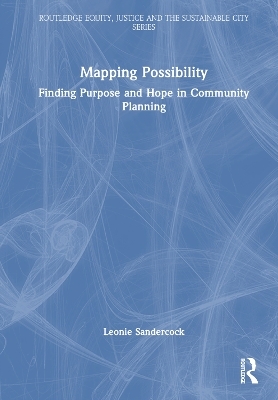
Mapping Possibility
Routledge (Verlag)
978-1-032-35132-2 (ISBN)
- Titel z.Zt. nicht lieferbar
- Versandkostenfrei innerhalb Deutschlands
- Auch auf Rechnung
- Verfügbarkeit in der Filiale vor Ort prüfen
- Artikel merken
Mapping Possibility traces the intertwined intellectual, professional, and emotional life of Leonie Sandercock. With an impressive career spanning nearly half a century as an educator, researcher, artist, and practitioner, Sandercock is one of the leading figures in community planning, dedicating her life to pursuing social, cultural, and environmental justice through her work.
In this book, Leonie Sandercock reflects on her past writings and films, which played an important role in redefining the field in more progressive directions, both in theory and practice. It includes previously published essays in conjunction with insightful commentaries prefacing each section, and four new essays, two discussing Sandercock’s most recent work on a feature-film project with Indigenous partners. Innovative, visionary, and audacious, Leonie’s community-based scholarship and practice in the fields of urban planning and community development have engaged some of the most intractable issues of our time – inequality, discrimination, and racism. Through award-winning books and films, she has influenced the planning field to become more culturally fluent, addressing diversity and difference through structural change.
This book draws a map of hope for emerging planners dedicated to equity, justice, and sustainability. It will inspire the next generation of community planners, as well as current practitioners and students in planning, cultural studies, urban studies, architecture, and community development.
Leonie Sandercock is a professor at the School of Community and Regional Planning at the University of British Columbia, Canada. Her main research interest is in working with First Nations through collaborative community planning, using the medium of film as a catalyst for dialogue on the possibilities of healing, reconciliation, and partnership. Other research interests include immigration, cultural diversity, and integration; the possibilities of a more therapeutic model of planning; the importance of stories and storytelling in planning theory and practice; and the role of multimedia in planning.
Introduction; PART I Diversifying Planning’s History, Theory, and Epistemology; Commentary: The Los Angeles Years: 1986–1996; 1 Rewriting Planning History: Official and Insurgent Stories (1998); 2 Who Knows?: Exploring Planning’s Knowledges (2003); 3 Voices from the Borderlands: A Meditation on a Metaphor (1995); PART II Imagining Cities of Difference; Commentary: The Cosmopolis Project: From Theory to Practice, 1992–2006; 4 Towards Cosmopolis: A Postmodern Utopia (1998); 5 When Strangers Become Neighbors: Managing Cities of Difference (2000); 6 Mongrel Cities of the 21st Century: Is Multiculturalism the Solution, or the Problem? (2006); PART III Expanding the Language of Planning; Commentary: The Storytelling Project: 1986–2022; 7 Out of the Closet: The Importance of Stories and Storytelling in Planning Practice (2003); 8 Digital Ethnography as Planning Praxis: An Experiment with Film as Social Research, Community Engagement, and Policy Dialogue (2010); 9 Changing the Lens: Film as Action Research and Therapeutic Planning Practice; 10 Edge of the Knife: Film as a Catalyst for Indigenous Cultural Revitalization? (2022); PART IV Navigating Indigenous Worlds: Praxis and Pedagogy; Commentary: The Inner Journey: 2007–2022; 11 Finding My Way: Emotions and Ethics in Community-Based Action Research with Indigenous Communities (2018); 12 Partnership Praxis in a ‘Reconciliation’ Context: What Is Mine to Do? (2022); 13 Beyond Cosmopolis: Dreaming Co-existence as Indigenous Justice (2019); Conclusion: Mapping Possibility: The View from 2022; Commentary: Beneath the Pavement, the Beach?; 14 Once Upon a Planet: Reimagining the Soul of Planning (2022)
| Erscheinungsdatum | 04.08.2022 |
|---|---|
| Reihe/Serie | Routledge Equity, Justice and the Sustainable City series |
| Zusatzinfo | 10 Halftones, color; 10 Illustrations, color |
| Verlagsort | London |
| Sprache | englisch |
| Maße | 174 x 246 mm |
| Gewicht | 820 g |
| Themenwelt | Naturwissenschaften ► Biologie ► Ökologie / Naturschutz |
| Naturwissenschaften ► Geowissenschaften ► Geografie / Kartografie | |
| Sozialwissenschaften ► Soziologie | |
| Technik ► Architektur | |
| ISBN-10 | 1-032-35132-2 / 1032351322 |
| ISBN-13 | 978-1-032-35132-2 / 9781032351322 |
| Zustand | Neuware |
| Informationen gemäß Produktsicherheitsverordnung (GPSR) | |
| Haben Sie eine Frage zum Produkt? |
aus dem Bereich


